1. The document discusses the potential uses of social media analytics in local government. It identifies four main purposes: communication, public relations, customer services, and public consultation/engagement.
2. It details a research project with two UK city councils that included a workshop introducing social media analytics tools and interviews. The workshop aimed to demonstrate tools and generate reflection on their value.
3. Interview findings suggested analytics could provide insights supplementing existing knowledge of public networks and discussions. Tools were seen as potentially valuable across different council departments.

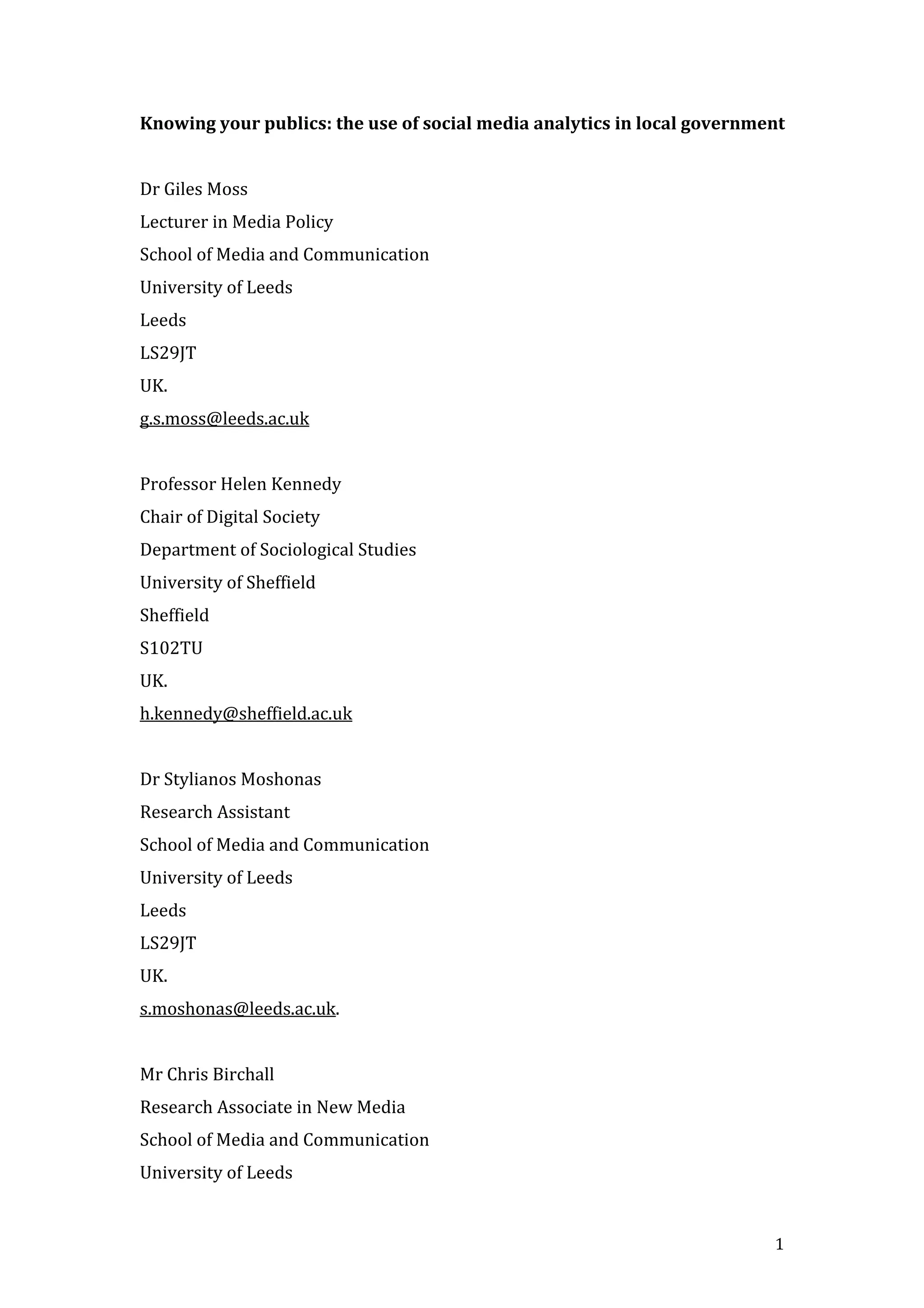

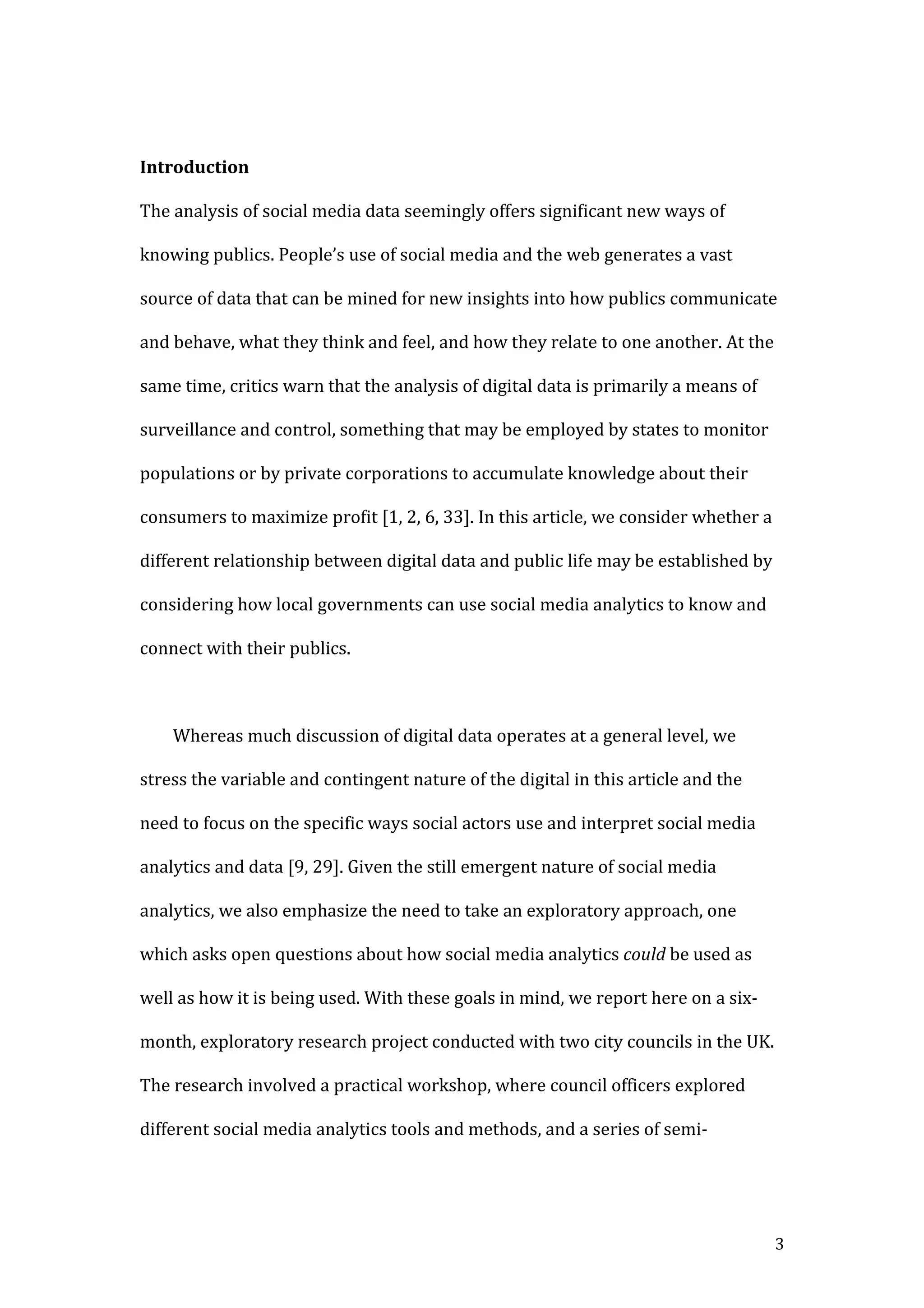
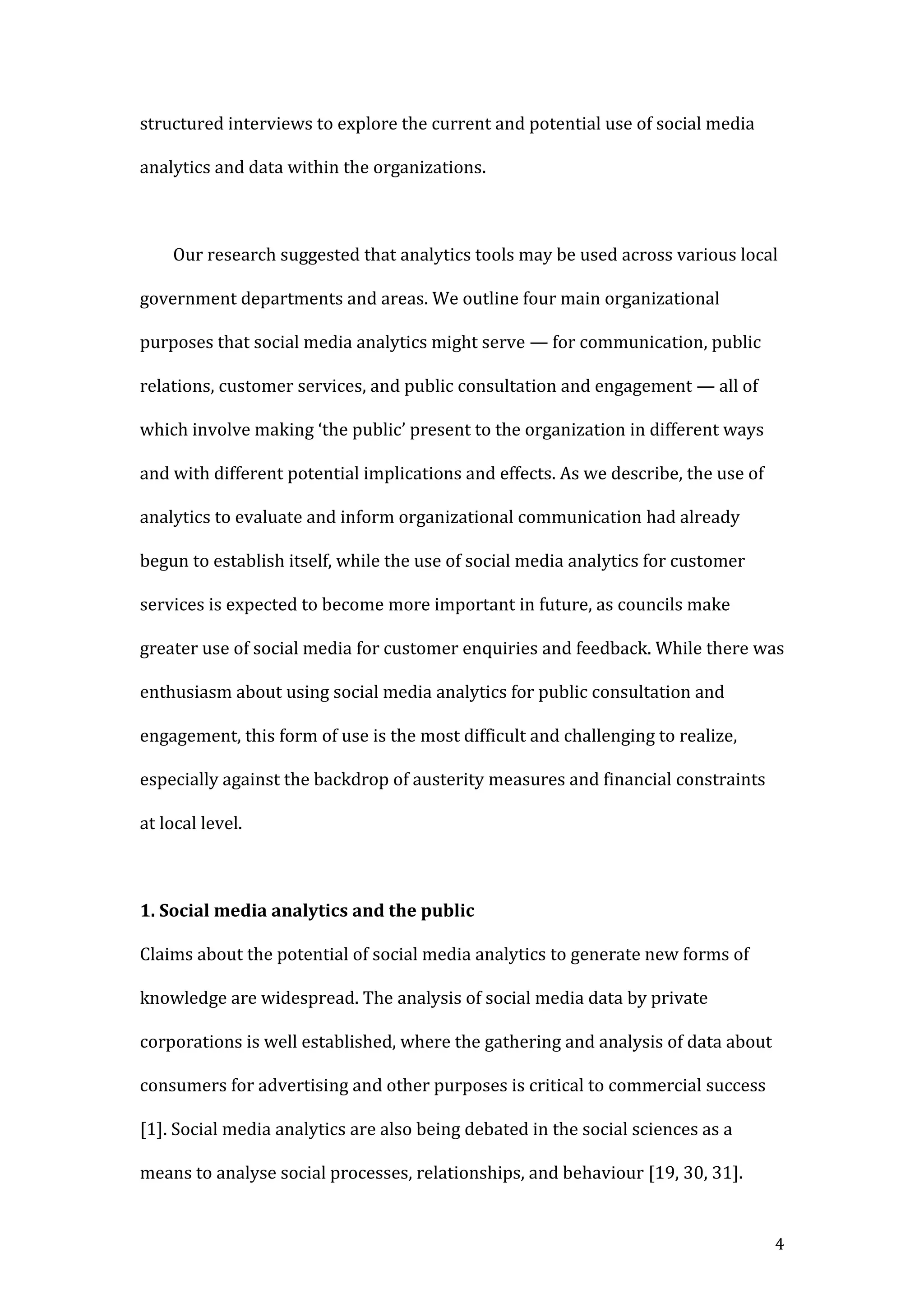


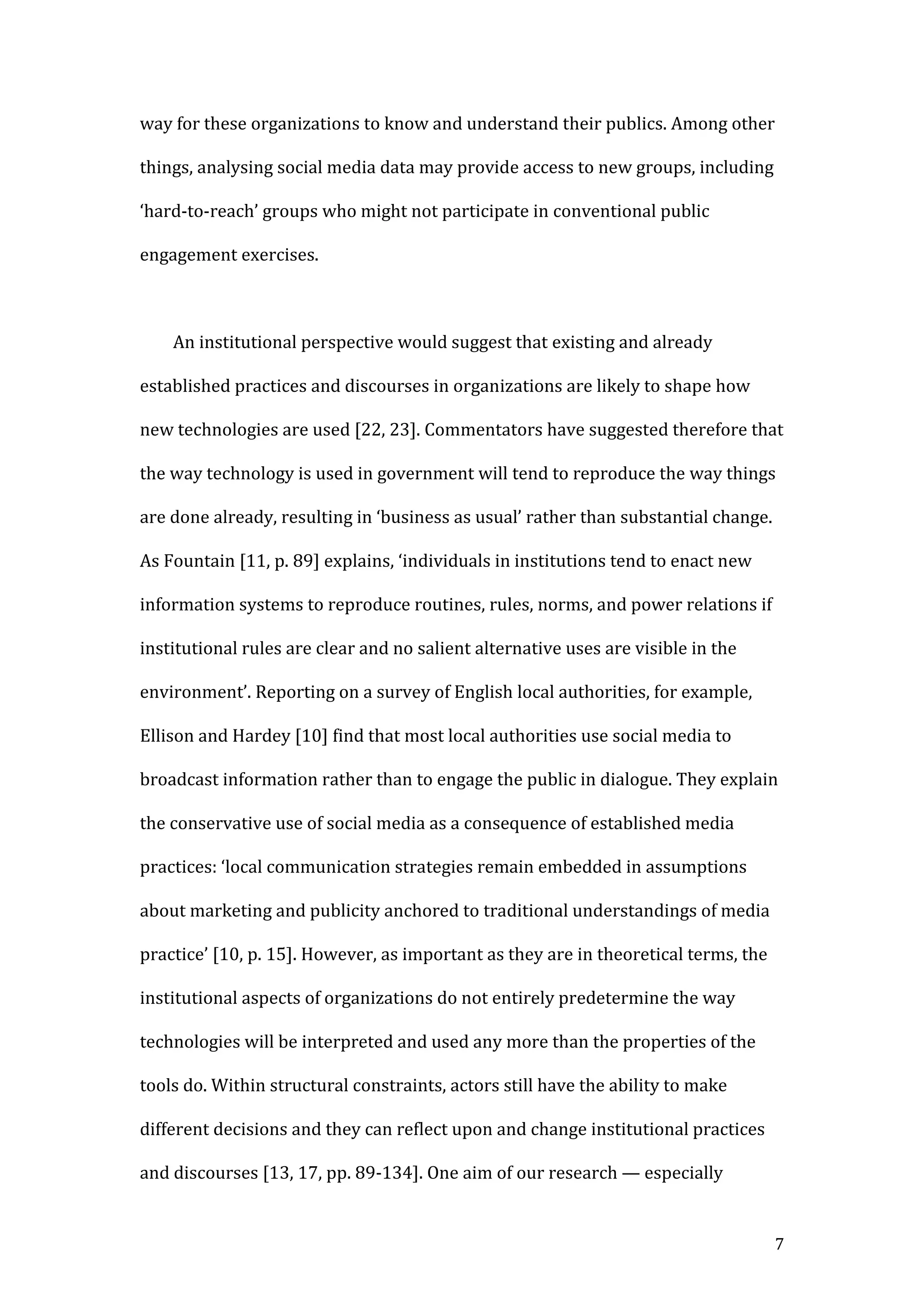


![3
Introduction
The analysis of social media data seemingly offers significant new ways of
knowing publics use of social media and the web generates a vast
source of data that can be mined for new insights into how publics communicate
and behave, what they think and feel, and how they relate to one another. At the
same time, critics warn that the analysis of digital data is primarily a means of
surveillance and control, something that may be employed by states to monitor
populations or by private corporations to accumulate knowledge about their
consumers to maximize profit [1, 2, 6, 33]. In this article, we consider whether a
different relationship between digital data and public life may be established by
considering how local governments can use social media analytics to know and
connect with their publics.
Whereas much discussion of digital data operates at a general level, we
stress the variable and contingent nature of the digital in this article and the
need to focus on the specific ways social actors use and interpret social media
analytics and data [9, 29]. Given the still emergent nature of social media
analytics, we also emphasize the need to take an exploratory approach, one
which asks open questions about how social media analytics could be used as
well as how it is being used. With these goals in mind, we report here on a six-
month, exploratory research project conducted with two city councils in the UK.
The research involved a practical workshop, where council officers explored
different social media analytics tools and methods, and a series of semi-](https://image.slidesharecdn.com/knowingyourpublic-170107225753/75/Knowing-your-public-11-2048.jpg)
![4
structured interviews to explore the current and potential use of social media
analytics and data within the organizations.
Our research suggested that analytics tools may be used across various local
government departments and areas. We outline four main organizational
purposes that social media analytics might serve for communication, public
relations, customer services, and public consultation and engagement all of
which involve making the public to the organization in different ways
and with different potential implications and effects. As we describe, the use of
analytics to evaluate and inform organizational communication had already
begun to establish itself, while the use of social media analytics for customer
services is expected to become more important in future, as councils make
greater use of social media for customer enquiries and feedback. While there was
enthusiasm about using social media analytics for public consultation and
engagement, this form of use is the most difficult and challenging to realize,
especially against the backdrop of austerity measures and financial constraints
at local level.
1. Social media analytics and the public
Claims about the potential of social media analytics to generate new forms of
knowledge are widespread. The analysis of social media data by private
corporations is well established, where the gathering and analysis of data about
consumers for advertising and other purposes is critical to commercial success
[1]. Social media analytics are also being debated in the social sciences as a
means to analyse social processes, relationships, and behaviour [19, 30, 31].](https://image.slidesharecdn.com/knowingyourpublic-170107225753/75/Knowing-your-public-12-2048.jpg)
![5
Closest to our concerns, some commentators have discussed the use of social
media data [3]
consultancy firms are analysing online data through social media in order to
track public opinion during election periods, while Bruns et al. [8] examine the
use of digital methods
http://mappingonlinepublics.net). Gillespie [14] discusses how representations
of the public generated through data are an
increasingly conspicuous way of thinking about publics. He gives the example of
Twitter's algorithm for Trends, which claims to represent even if in just a crude
form what different geographical publics are discussing at particular moments
in time [14, p. 189].
In the growing debate about social media analytics, it is important that we
do not lose sight of the complex and contingent nature of the digital and the
different ways data may be used. We must, as Ruppert et al. [29, p. 31] propose,
be attentive not only to the digital in general terms, but to the more specific
mobilizations which allow the digital to be rendered visible and hence effective
in particular
digital, one that does not seek to ascribe fixed characteristics to it, but which
[29, p.
40]. Certainly, to understand social media analytics, we need to look beyond the
and analysing data. Software matters and has different
properties and assumptions built into it, but given what we know from social
studies of technology about the social shaping of technology, we can expect the](https://image.slidesharecdn.com/knowingyourpublic-170107225753/75/Knowing-your-public-13-2048.jpg)
![6
way software is interpreted and used by actors in different contexts to vary [18,
24]. As Fountain [12, p. 155] emphasizes in her work on technology use in
We need,
therefore, to study how analytics tools are enacted on the ground and what
practices and discourses shape or are likely to shape their use. Couldry [9, p.
892] has called this type of research the study of how social
actors are themselves using analytics - data measures of all kinds, including those
they have developed or customised to meet their own ends, for example, by
interpreting the world .
In this article, we focus on how social media analytics tools are and could be
used in local government in the UK. Like other public sector organizations, local
government authorities face the challenge of how to keep in touch with a
complex and changing public. Following budget cuts, this task has become more
challenging in recent years, yet arguably more important [20, pp. 23-25, 25]. As
Lowndes and Squires [21, p. 402] explain
change a shared and real-time understanding of the impact on local citizens and
local communities is essential, especially informing any re-design of services or
re- ncluding our partner
organizations) already adopt various methods to connect with their local publics
-
feedback mechanisms [4]. Social media data provide a potentially significant new](https://image.slidesharecdn.com/knowingyourpublic-170107225753/75/Knowing-your-public-14-2048.jpg)
![7
way for these organizations to know and understand their publics. Among other
things, analysing social media data may provide access to new groups, including
-to- who might not participate in conventional public
engagement exercises.
An institutional perspective would suggest that existing and already
established practices and discourses in organizations are likely to shape how
new technologies are used [22, 23]. Commentators have suggested therefore that
the way technology is used in government will tend to reproduce the way things
As Fountain [11, p. 89] ew
information systems to reproduce routines, rules, norms, and power relations if
institutional rules are clear and no salient alternative uses are visible in the
Ellison and Hardey [10] find that most local authorities use social media to
broadcast information rather than to engage the public in dialogue. They explain
the conservative use of social media as a consequence of established media
tegies remain embedded in assumptions
about marketing and publicity anchored to traditional understandings of media
[10, p. 15]. However, as important as they are in theoretical terms, the
institutional aspects of organizations do not entirely predetermine the way
technologies will be interpreted and used any more than the properties of the
tools do. Within structural constraints, actors still have the ability to make
different decisions and they can reflect upon and change institutional practices
and discourses [13, 17, pp. 89-134]. One aim of our research especially](https://image.slidesharecdn.com/knowingyourpublic-170107225753/75/Knowing-your-public-15-2048.jpg)
![8
through the workshop but also the interviews
existing institutional practices so that our research participants could reflect
upon the potential uses of social media analytics in their organizations and how
these uses could relate to and perhaps contribute to changing current practices.
Understanding how social media analytics connects with the public has
important implications for democracy at local level as elsewhere. Gillespie [14]
argues that the representations of the public generated through digital data do
, but also construct it in particular ways.
of representation, help to constitute and codify the publics they claim to
measure, publics that would not otherwise exist except that the algorithm called
them into existence? 14, p. 189]. In one respect, the constructed nature of
new: ing that can be known without
technologies of representation (such as opinion polls and elections) or
representatives (such as elected politicians and activists) who claim to represent
it [5, 27, 28, 32]. But then not all ways of representing the public digital or
otherwise are equal. The problem is not so much that the public is
represented through digital data, but that the public for particular commercial
and other purposes is being made present in ways that make little room for
democratic agency and reflection. Examining and thinking critically about the
different ways analytics may construct the public becomes vitally important in
this context.](https://image.slidesharecdn.com/knowingyourpublic-170107225753/75/Knowing-your-public-16-2048.jpg)







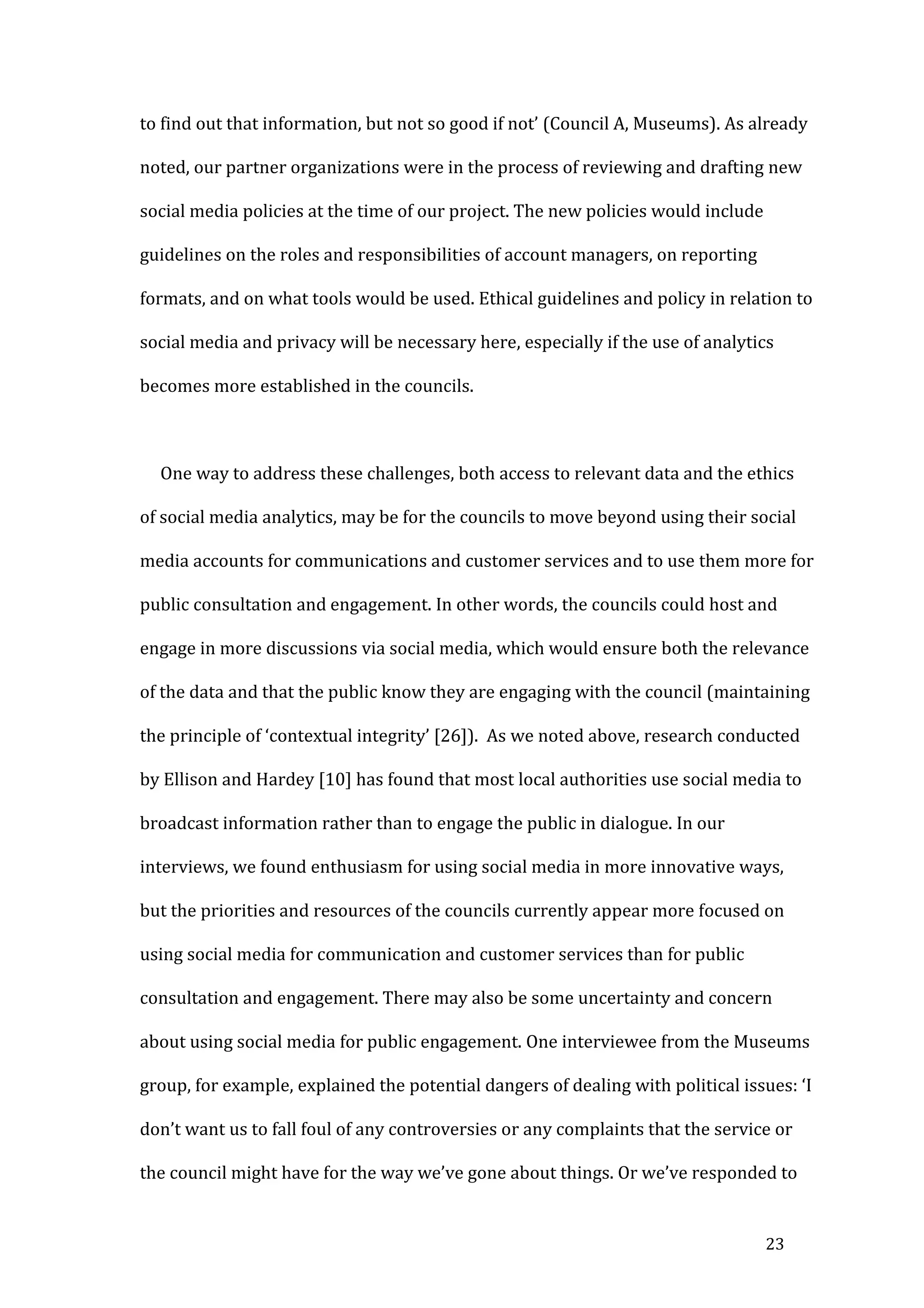



![20
l the time
there is a skills gap in getting the right people to do that work and to
have that understanding. (Council A, Customer Services)
If using analytics in relation to customer services would be difficult, its use
for public consultation and engagement would be the most challenging. Our research
participants were generally enthusiastic about the prospect of using social media as
a way to consult and engage the public, especially given the growing use of social
media for communications. However, social media analytics was not being used for
this purpose at the time of the research. Using social media analytics for public
consultation and engagement would require a significant investment of council
resources, but unlike customer services it is not associated discursively with
bringing about immediate cost-savings and greater efficiency.
Interviewees recognized that social media users are not fully representative or
inclusive of all the social groups that make up their local publics. There are
significant exclusions or absences in social media data: those who are not connected
to the internet will not be reflected in the data, while those who are not active
- 16] who can dominate
social media discussions. Still, it was hoped that new groups and issues that were not
known to the organization may still be identified in this way and so social media
analytics could be used to complement existing methods of public consultation and](https://image.slidesharecdn.com/knowingyourpublic-170107225753/75/Knowing-your-public-28-2048.jpg)
![21
engagement. However, there are various challenges the councils face in using social
media analytics for public consultation and engagement.
Firstly, where data are not directly linked to the council, identifying relevant social
media content from the mass of data available is difficult. Local data can be isolated
through the use of location data and metadata, but not all social data contain location
information: a location-aware device with location services turned on is required
and users need to have agreed to their location being shared. Alternatively, location
data can be derived from social media platforms but such information is not widely
available [15]. As a result, when geographical filters are applied, much potentially
relevant content is excluded (such as local people writing comments on newspaper
websites, forums, blogs, and in most cases Facebook and Twitter too) and the
amount of data is reduced considerably. In addition to using location information, a
common strategy is to use keywords to find data. But locating relevant data in this
way involves a complex process of trial and error that is time consuming and reliant
on expertise. Searches may either be too specific, producing small quantities of
relevant data, or too general, producing larger amounts of data but not all of which is
relevant. Of course, it is also difficult to know what data may be absent. One
-22 because
(Council A, Museums).
A second challenge is how to interpret the data generated. One interviewee
described how the tools are useful in catching is quite
difficult to draw practical conclusions from it for policymaking:](https://image.slidesharecdn.com/knowingyourpublic-170107225753/75/Knowing-your-public-29-2048.jpg)
![22
I mean I think the information is very good, how much we can
actually
other than maybe a general awareness. Sometimes we have to deal
with specific subjects and specific topics and they usually come
through via complaints. So somebody will usually complain about
the decision making process. What this does is this picks up on a level
of sort of background noise and that's use
difficult to get the context for it. (Council A, City Development)
Without further investigation, the result is that the data do not take a form that is
likely to be immediately useful to policymakers or others in the organization.
Finally, analysing social media content that has not been directed to the
council raises concerns about surveillance and the privacy of users. While social
that they produce in one context will be used for different purposes in another, and
] terms, may be
violated. As boyd and Crawford [7 ible does not
While this was not perceived as a pressing concern since neither of
the councils monitored and analysed social media systematically, our research
participants recognised this problem. One
quite realise actually how much stuff can be gathered on them.](https://image.slidesharecdn.com/knowingyourpublic-170107225753/75/Knowing-your-public-30-2048.jpg)